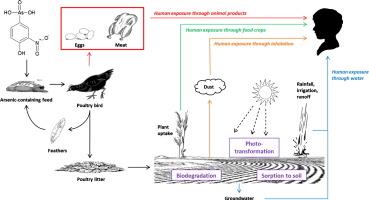Organoarsenicals in poultry litter: Detection,fate, and toxicity |
| |
| Affiliation: | 1. Department of Chemical, Biochemical and Environmental Engineering, University of Maryland Baltimore County, 1000 Hilltop Circle, Baltimore, MD 21250, USA;2. Department of Civil Engineering, Indian Institute of Engineering Science and Technology, Shibpur, Howrah, West Bengal 711103, India;1. Department of Environmental Science, School of Resources and Environmental Science, Wuhan University, Wuhan 430079, China;2. School of Civil Engineering, Wuhan University, Wuhan 430072, China |
| |
| Abstract: | 
Arsenic contamination in groundwater has endangered the health and safety of millions of people around the world. One less studied mechanism for arsenic introduction into the environment is the use of organoarsenicals in animal feed. Four organoarsenicals are commonly employed as feed additives: arsanilic acid, carbarsone, nitarsone, and roxarsone. Organoarsenicals are composed of a phenylarsonic acid molecule with substituted functional groups. This review documents the use of organoarsenicals in the poultry industry, reports analytical methods available for quantifying organic arsenic, discusses the fate and transport of organoarsenicals in environmental systems, and identifies toxicological concerns associated with these chemicals. In reviewing the literature on organoarsenicals, several research needs were highlighted: advanced analytical instrumentation that allows for identification and quantification of organoarsenical degradation products; a greater research emphasis on arsanilic acid, carbarsone, and nitarsone; identification of degradation pathways, products, and kinetics; and testing/development of agricultural wastewater and solid treatment technologies for organoarsenical-laden waste. |
| |
| Keywords: | |
| 本文献已被 ScienceDirect 等数据库收录! |
|

